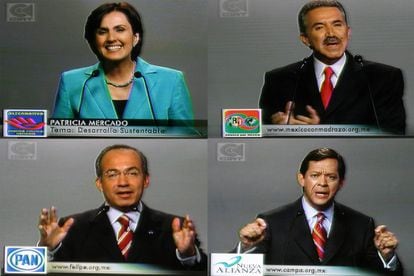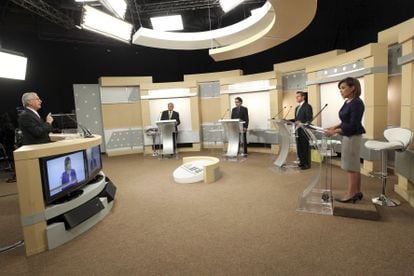The history of debates between presidential candidates in Mexico is about to turn 30 next May and its memorable moments range from gestures and absences to finger-pointing and mischief. The formats have evolved from the rigid and stuffy nature of the first meeting in 1994, in which the host Mayte Noriega was only responsible for giving the floor to each candidate, to a more fluid dynamic like that of the 2018 debates, in which the Candidates interacted more freely, the moderators were more proactive and citizens participated with questions for the contenders. The initial paradigm that prioritized the interests of the parties and candidates was replaced over time by another that “put citizens' right to information at the center” and sought for debates to become “a tool for the exercise of free and informed voting,” says Lorenzo Córdova, who was president of the National Electoral Institute (INE) between 2014 and 2018, in an academic article on the paradigms of the debates.
This is a review of the memorable events in some of the 10 meetings between candidates that have been held in the run-up to five elections: 1994, 2000, 2006, 2012 and 2018. From 2000 to 2012, two debates were held before each election and In 2018 there were three.
1994: the rhetoric of 'The Boss' Diego
The first presidential debate in the history of Mexico was held on May 12, 1994, almost two months after the assassination of Luis Donaldo Colosio (1950-1994), who was the candidate of the Institutional Revolutionary Party (PRI). In his place, Ernesto Zedillo was appointed as PRI standard bearer, who would end up governing from that year until 2000.
From this meeting we remember the eloquence and orator capacity of the candidate of the National Action Party (PAN), Diego Fernández de Cevallos, known as The boss Diego, who launched an accurate criticism of Zedillo for having been designated as a candidate by presidential decision of Carlos Salinas de Gortari, at a time when the hegemony of the PRI received harsh questions from the opposition, PAN members and PRD members, among them the candidate of the Party of the Democratic Revolution (PRD) in that year, Cuauhtémoc Cárdenas.
Fernández de Cevallos told Ernesto Zedillo: “You are here as a consequence of two tragedies: on the one hand, the death of Colosio and, on the other, the presidential appointment. The first one surpasses you, it is not your fault, but the second one disqualifies you. […] If we Mexicans have to believe you that it is a democratic option, we would have to believe Aburto (the confessed murderer of Luis Donaldo Colosio) that he is a pacifist.”
Both Chief Diego and Cárdenas insisted during their interventions on the urgency of democratizing Mexico after the PRI presidents had governed for more than six decades.
2000: Fox's 'today' and Labastida's complaint
Six years later, the PAN member Vicente Fox, a candidate who went outside the canon of the discursive formality of the candidates, would utter one of the phrases that are most remembered in almost three decades of debates. In a press conference on the day they had agreed to hold the second meeting of the year 2000, the other two candidates, Cuauhtémoc Cárdenas and the PRI Francisco Labastida, defended that there were no conditions to carry out the debate that the three leaders in the polls they agreed Before the television cameras and live, Cárdenas and Labastida insisted to Fox that the best option was to postpone it. “Today,” said the PAN member; “Friday,” the PRD member proposed. Again: “today”, “on Friday”. “Today,” Vicente Fox persisted. The debate did not take place that afternoon, but days later, on May 26.
Previously, in the first meeting of that year, on April 25, the PRI member Labastida complained about Fox with a phrase that also remained in the memory of society: “He called me 'short', he called me 'sissy', He told me 'the dressed one'. And he challenged the PAN member: “You should not run away from his words. If he is ashamed of them, then let him admit it.” Fox responded: “Perhaps the stupidity will go away from me, but it will never go away from you, the crafty, the bad at governing and the corrupt.”
2006: López Obrador's empty lectern

At the first of the two debates in 2006, when Andrés Manuel López Obrador was the candidate of the For the Good of All coalition, made up of the PRD, the Labor Party (PT) and Convergencia, the current president of Mexico did not attend. The polls placed him at the head of the electoral preferences and his campaign strategy consisted of avoiding that meeting on April 25. His absence became more noticeable when the organizers, the then Federal Electoral Institute (IFE) and the National Chamber of the Radio and Television Industry (CIRT), decided to place the lectern that corresponded to López Obrador despite the absence of he. “Andrés Manuel López Obrador, of the For the Good of All coalition, decided not to attend this presidential debate,” said host Guadalupe Juárez at the meeting attended by Felipe Calderón, Roberto Madrazo, Patricia Mercado and Roberto Campa.
On June 6, 2006, the five candidates, including López Obrador, attended the second debate.
2012: Quadri's prying eyes

Only one minute had passed since the start of the first debate of 2012, held on May 6, when the most remembered and commented moment of the meeting occurred at a time when Twitter and Facebook were growing in relevance. The candidate of the New Alliance party, Gabriel Quadri, had just taken the role that corresponded to him to define the turn of his initial participation and his gaze was directed to the figure of the aide-de-camp who distributed the turns on a transparent tray, Julia Orayen . “IFE aide-de-camp” immediately became a trend on social media.
The format had changes compared to previous years, but it privileged consensus between the parties, so the result maintained a certain rigidity that complicated the dynamics. “Although the contenders resorted profusely to the support of visual materials, on many occasions they were shown outside the frame, which could not be modified to allow them to be seen,” says Lorenzo Córdova in his text on the paradigms of the presidential debates. .
In the second meeting, on June 10, 2012, the format was sought to be made more flexible.
2018: the wallet and the nickname
In 2018, for the first time, three debates were held before an election. Previous experiences led the INE to look for an open format with a greater variety of tools in the interaction of candidates, moderators and citizens. The first meeting, on April 22, was held at the Mining Palace, in Mexico City. The then candidate Andrés Manuel López Obrador had decided not to risk, which had favored Ricardo Anaya, the PAN candidate, who managed to show solidity in his interventions. The second debate, held in the gymnasium of the Tijuana campus of the Autonomous University of Baja California, had as its symbolism that it was located a kilometer and a half from where Luis Donaldo Colosio had been murdered 24 years ago, in Lomas Taurinas. “Democracy was recreated in an unprecedented exercise,” indicates Córdova in his analysis. The candidates were standing, the moderators were sitting, and behind them there were citizens sitting on bleachers who were asking questions to the participants.
In that scenario, López Obrador found the right circumstances to move from his place, gesture and make gestures. It was in that context that during an approach on foot by Ricardo Anaya to question the Morena candidate, he took out his wallet from a bag in his bag and said: “I'm going to take care of my wallet. Don’t get too close to me,” as he smiled mockingly. Anaya continued talking. In another intervention, the PAN member pointed out López Obrador because one of his children studied in Spain. “Isn't that very nationalist?” He said. Then came the response from the current president: “It's Ricky Riquín… Canallín.” Moments later he showed a copy of the magazine Process which read “The shady income of the Anayas.” At least 12.6 million people watched the meeting on television and more than three million through the INE's social networks.
Subscribe to the EL PAÍS Mexico newsletter and to the channel electoral WhatsApp and receive all the key information on current events in this country.
#time #López #Obrador #left #lectern #empty #memorable #moments #presidential #debates #Mexico
/cloudfront-eu-central-1.images.arcpublishing.com/prisa/U45D3HQVB5DETFHEUOSH6QGU6A.jpg)
Leave a Reply